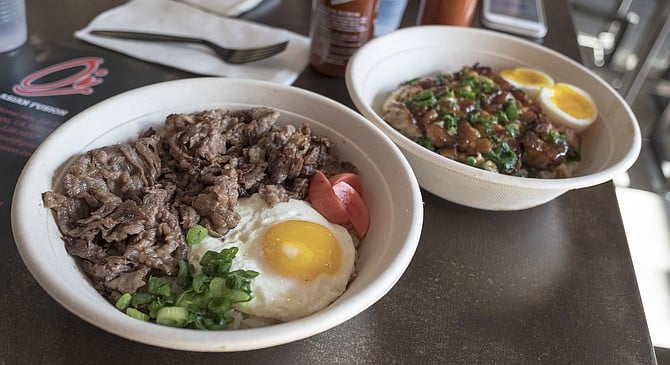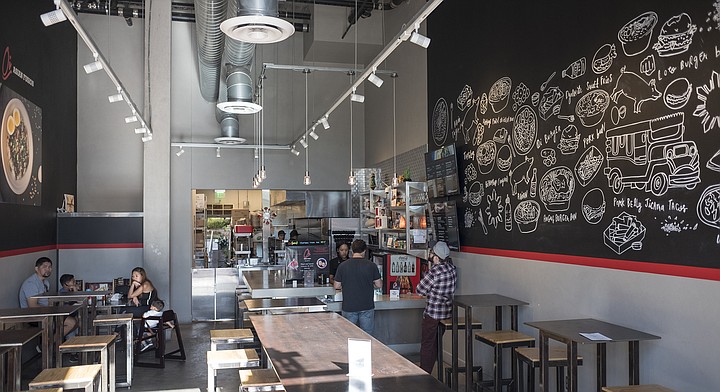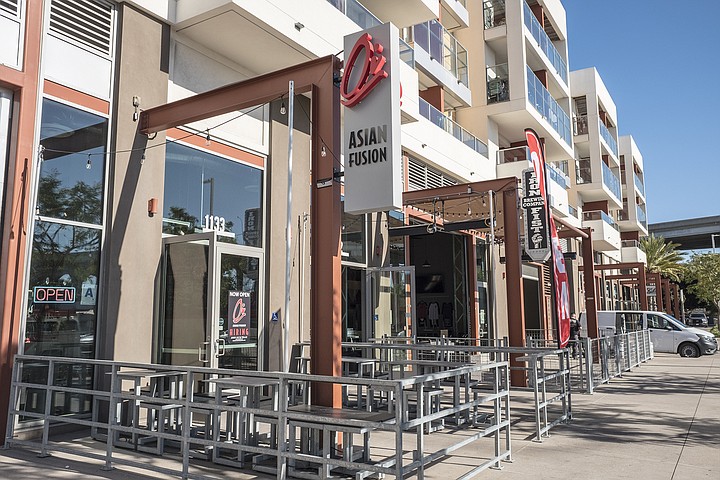 Facebook
Facebook
 X
X
 Instagram
Instagram
 TikTok
TikTok
 Youtube
Youtube

All last year, I kept seeing food stories predicting Filipino food would the next great American food trend in 2018. Celebrity foodies such as Andrew Zimmern and Anthony Bourdain said so, and their claims were touted by publications including Bloomberg, Esquire, and even — I wouldn't lie about this — Vogue magazine.
Right on cue, a Los Angeles Filipino concept out of Los Angeles has expanded to San Diego. As its name suggests, Oi Asian Fusion technically draws from multiple Asian culinary traditions. But, as the restaurant has it, the name Oi, (pronounced Oy) is a Filipino greeting equivalent to "Hey," and judging by my first couple of visits, Filipino influences stand out.

Now, as denizens of National City and Mira Mesa will tell you, plenty of Filipino restaurants have earned loyal customers in those parts of town for years. The biggest difference with Oi, other than its Barrio Logan location, may be that it simplifies the dining experience with familiar fast casual tropes.

Rice bowls comprise the bulk of the menu, and so trying the different dishes proves as accessible as trying a different preparation of meat served over white rice. So there's a loco burger bowl with fried egg, adapted from Hawaii's loco moco; a karaage bowl featuring Japanese inspired fried chicken; and a ground chicken longanisa, rooted in Filipino sausage. Each go for $8.50.
The dishes most recommended when I ordered at the counter were the adobo pork belly and tapsilog beef. The Spanish influenced adobo is probably the most well known Filipino dish here in American (after the egg-roll like lumpia), and while I've eaten it numerous times with chicken, I'd never enjoyed a braised pork belly presentation.
Both texture and flavor hit the mark. The tender belly played very well with paprika and vinegar-based marinade, and the two halves of a perfectly soft boiled egg add gooey egg yolk to the mix — if you want to start somewhere, do it here.
The tapsilog hails from a dish of thinly sliced beef served with a fried egg over garlicky rice. It's tough to tell what goes into the sauce flavoring Oi's thinly sliced brisket, but it seems to feature some citrus and/or vinegar to give the meat a much higher degree of acidity than we typically encounter with beef in the U.S. This proved another boldly flavored dish that was all to easy to devour quickly.
If you've never tried Filipino cuisine before, you might wonder whether some of these dishes have been over-salted. But they're supposed to taste like that. Part of the joy of trying these and a number Pacific island dishes is discovering the way salt and acids work together. It can seem extreme to the uninitiated palate, the same way a habanero salsa might.
If you're interested in toning that down, look to Oi's sauce menu. For about 60 cents apiece, you can add a small ramekin of cilantro cream, garlic sauce, dynamite sauce (spicy mayo), or wasabi cream to any dish. I gave a taste to the enigmatic umami gravy, which especially lived up to its name. They wouldn't tell me what all goes into the richly umami concoction, other than to indicate it's bolstered by fish sauce. Nevertheless, it will be a standard add-on to all my future orders.
The only thing stopping me from making this a weekly stop in the rotation of quick stop meals is a relative lack of vegetables. Aside from scallions in the adobo, pickled radish in the tapsilog, and scattered seaweed and mushrooms in other dishes, there aren't a enough veggies to go around here. At least til the shop adds the vegetable bibimbap from its original Canoga Park restaurant. In the meantime, people who enjoy meat over rice should check out Oi, and prepare to jump on the Filipino food bandwagon.


All last year, I kept seeing food stories predicting Filipino food would the next great American food trend in 2018. Celebrity foodies such as Andrew Zimmern and Anthony Bourdain said so, and their claims were touted by publications including Bloomberg, Esquire, and even — I wouldn't lie about this — Vogue magazine.
Right on cue, a Los Angeles Filipino concept out of Los Angeles has expanded to San Diego. As its name suggests, Oi Asian Fusion technically draws from multiple Asian culinary traditions. But, as the restaurant has it, the name Oi, (pronounced Oy) is a Filipino greeting equivalent to "Hey," and judging by my first couple of visits, Filipino influences stand out.

Now, as denizens of National City and Mira Mesa will tell you, plenty of Filipino restaurants have earned loyal customers in those parts of town for years. The biggest difference with Oi, other than its Barrio Logan location, may be that it simplifies the dining experience with familiar fast casual tropes.

Rice bowls comprise the bulk of the menu, and so trying the different dishes proves as accessible as trying a different preparation of meat served over white rice. So there's a loco burger bowl with fried egg, adapted from Hawaii's loco moco; a karaage bowl featuring Japanese inspired fried chicken; and a ground chicken longanisa, rooted in Filipino sausage. Each go for $8.50.
The dishes most recommended when I ordered at the counter were the adobo pork belly and tapsilog beef. The Spanish influenced adobo is probably the most well known Filipino dish here in American (after the egg-roll like lumpia), and while I've eaten it numerous times with chicken, I'd never enjoyed a braised pork belly presentation.
Both texture and flavor hit the mark. The tender belly played very well with paprika and vinegar-based marinade, and the two halves of a perfectly soft boiled egg add gooey egg yolk to the mix — if you want to start somewhere, do it here.
The tapsilog hails from a dish of thinly sliced beef served with a fried egg over garlicky rice. It's tough to tell what goes into the sauce flavoring Oi's thinly sliced brisket, but it seems to feature some citrus and/or vinegar to give the meat a much higher degree of acidity than we typically encounter with beef in the U.S. This proved another boldly flavored dish that was all to easy to devour quickly.
If you've never tried Filipino cuisine before, you might wonder whether some of these dishes have been over-salted. But they're supposed to taste like that. Part of the joy of trying these and a number Pacific island dishes is discovering the way salt and acids work together. It can seem extreme to the uninitiated palate, the same way a habanero salsa might.
If you're interested in toning that down, look to Oi's sauce menu. For about 60 cents apiece, you can add a small ramekin of cilantro cream, garlic sauce, dynamite sauce (spicy mayo), or wasabi cream to any dish. I gave a taste to the enigmatic umami gravy, which especially lived up to its name. They wouldn't tell me what all goes into the richly umami concoction, other than to indicate it's bolstered by fish sauce. Nevertheless, it will be a standard add-on to all my future orders.
The only thing stopping me from making this a weekly stop in the rotation of quick stop meals is a relative lack of vegetables. Aside from scallions in the adobo, pickled radish in the tapsilog, and scattered seaweed and mushrooms in other dishes, there aren't a enough veggies to go around here. At least til the shop adds the vegetable bibimbap from its original Canoga Park restaurant. In the meantime, people who enjoy meat over rice should check out Oi, and prepare to jump on the Filipino food bandwagon.
Comments